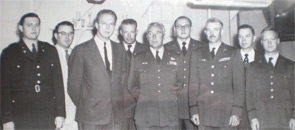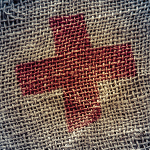In 1940, with clouds of war looming on the horizon, President Roosevelt created the Armed Forces Epidemiological Board (AFEB), a unique ”think tank” designed to anticipate the medical problems that the military would encounter during a war involving Europe, Asia, Africa, and the South Pacific. The members of the AFEB were some of the most outstanding academicians in the United States, weighted toward experts in infectious disease, and they served without remuneration or public acclaim, and their efforts remained largely anonymous. They organized and funded research programs to control the contagious and epidemic illnesses which historically followed armies in the field and they were responsible for minimizing many of these scourges. Over the next two decades, the AFEB was a major medical research effort by the federal government and this group served as the matrix for the subsequent development of the National Institutes of Health (NIH).
In 1948, the Streptococcal Disease Commission, a division of the AFEB, funded a research unit through Western Reserve University: the Streptococcal Disease Laboratory, under the direction of Charles Rammelkamp, Jr., MD. This organization was a function of the Department of Defense with the explicit mandate to rapidly find effective methods to treat, prevent, and control the group A streptococcal infections and their sequelae, acute rheumatic fever (ARF) and acute glomerulonephritis (AGN).
During World War II, group A streptococcal infections became the bane of the military bases. Thousands of young men were brought together at training bases and became a marvelous bacterial incubator. Epidemics of strep throat literally closed down training at bases such as Great Lakes Naval Base. It was estimated that during the war, respiratory disease was responsible for keeping the equivalent of two military divisions out of combat. And the costs in money and future health problems of thousands of individuals who suffered ARF are incalculable. At one time, a naval training base in Idaho was converted into a gigantic rheumatic fever hospital. With the impending Cold War, this medical disaster could not be repeated.
In order to staff the Streptococcal Disease Laboratory, the Department of Defense selected a group of young physicians from the selective service pool for immediate military service. These physicians were specifically chosen because of their research interests and ability and were plucked out of their residencies or research fellowships. I joined the staff at age 23—barely two years out of medical school, the youngest of the group—and remained at the Strep Lab for over two years while participating in all of the ongoing studies. During the seven years that the laboratory functioned, an additional 14 physicians sequentially participated in the clinical, epidemiologic, and laboratory research activities and published more than 60 original research papers on their activities while fulfilling their 24-month military obligation to the government.

Groundbreaking Research on Streptococcus
The Strep Lab was set up at a large military training base known to have had yearly epidemics of streptococcal sore throat, which provided the “population-at-risk” necessary to conduct the studies. The initial survey was to determine the natural history of untreated streptococcal sore throat, because this information was sadly lacking. In brief, it was found that, left untreated, the acute febrile illness would last one week and subside with minimal residua other than infrequent, treatable, suppurative complications. After an asymptomatic period of 14 to 28 days, about 3% to 5% of the patients would develop clinical ARF.

